Specificity of Meteorological and Biometeorological Conditions in Central Europe in Centre of Urban Areas in June 2019 (Bydgoszcz, Poland)
Abstract
1. Introduction
2. Materials and Methods
3. Results
4. Discussion
5. Conlusions
- -
- during a heat wave, the maximum air temperature in the city center may exceed 36.0 °C
- -
- the temperature exceeds the threshold of 30.0 °C, indicating the presence of hot conditions, usually starting before 1 p.m. and lasting until the evening hours
- -
- the daily maximum temperature, and at the same time the most onerous bioclimatic conditions in the city, usually occur around 4:00 p.m.
- -
- in the city, the heat load on the human body during hot days varies from no heat to a very strong heat stress, at the same time thermal sensations vary from cool to very hot
- -
- there is a possibility of hyperthermia, which in extreme cases may appear after an hour
- -
- in terms of the possibility of dehydration, the most dangerous hours are 3:40 p.m.–4:50 p.m., when water losses with moderate activity can be as much as 775 g∙hour−1
- -
- during hot afternoon hours (around 4:00 p.m.), the risk of low oxygen content in the air is observed
Funding
Institutional Review Board Statement
Informed Consent Statement
Data Availability Statement
Conflicts of Interest
References
- Beniston, M. The 2003 Heat Wave in Europe: A Shape of Things to Come? An Analysis Based on Swiss Climatological Data and Model Simulations. Geophys. Res. Lett. 2004, 31. [Google Scholar] [CrossRef]
- Founda, D.; Pierros, F.; Katavoutas, G.; Keramitsoglou, I. Observed Trends in Thermal Stress at European Cities with Different Background Climates. Atmosphere 2019, 10, 436. [Google Scholar] [CrossRef]
- Meehl, G.A. More Intense, More Frequent, and Longer Lasting Heat Waves in the 21st Century. Science 2004, 305, 994–997. [Google Scholar] [CrossRef]
- Kuchcik, M.; Błażejczyk, K.; Halaś, A. Long-Term Changes in Hazardous Heat and Cold Stress in Humans: Multi-City Study in Poland. Int. J. Biometeorol. 2021, 1–12. [Google Scholar] [CrossRef]
- Russo, S.; Sillmann, J.; Fischer, E.M. Top Ten European Heatwaves since 1950 and Their Occurrence in the Coming Decades. Environ. Res. Lett. 2015, 10, 124003. [Google Scholar] [CrossRef]
- Barriopedro, D.; Fischer, E.M.; Luterbacher, J.; Trigo, R.M.; Garcia-Herrera, R. The Hot Summer of 2010: Redrawing the Temperature Record Map of Europe. Science 2011, 332, 220–224. [Google Scholar] [CrossRef] [PubMed]
- Grumm, R.H. The Central European and Russian Heat Event of July–August 2010. Bull. Am. Meteorol. Soc. 2011, 92, 1285–1296. [Google Scholar] [CrossRef]
- Hoy, A.; Hänsel, S.; Skalak, P.; Ustrnul, Z.; Bochníček, O. The Extreme European Summer of 2015 in a Long-Term Perspective. Int. J. Climatol. 2017, 37, 943–962. [Google Scholar] [CrossRef]
- Hoy, A.; Hänsel, S. Sommer Ohne Ende: Raum-Zeitliche Bewertung der 2018er Hitzeepisoden in Europa im Langzeitlichen Kontext; Garmisch-Partenkirchen, DACH2019 Abstracts; Deutscher Wetterdienst: Offenbach, Germany, 2019. [Google Scholar]
- Sousa, P.M.; Barriopedro, D.; Ramos, A.M.; García-Herrera, R.; Espírito-Santo, F.; Trigo, R.M. Saharan Air Intrusions as a Relevant Mechanism for Iberian Heatwaves: The Record Breaking Events of August 2018 and June 2019. Weather Clim. Extrem. 2019, 26, 100224. [Google Scholar] [CrossRef]
- Sulikowska, A.; Wypych, A. How Unusual Were June 2019 Temperatures in the Context of European Climatology? Atmosphere 2020, 11, 697. [Google Scholar] [CrossRef]
- ECMWF. Copernicus Climate Change Service; European Union: London, UK, 2019. [Google Scholar]
- Zhao, W.; Zhou, N.; Chen, S. The Record-Breaking High Temperature over Europe in June of 2019. Atmosphere 2020, 11, 524. [Google Scholar] [CrossRef]
- Xu, P.; Wang, L.; Liu, Y.; Chen, W.; Huang, P. The Record-breaking Heat Wave of June 2019 in Central Europe. Atmos. Sci. Lett. 2020, 21, e964. [Google Scholar] [CrossRef]
- Polish Climate Monitoring Bulletin; Institute of Meteorology and Water Management—National Research Institute: Warsaw, Poland, 2019.
- Available online: https://www.ogimet.com/gsynres.phtml.en (accessed on 14 April 2020).
- Wetter und Klima—Grosswetterlagen Forecast; Deutscher Wetterdienst: Offenbach am Main, Germany, 2019.
- Twardosz, R.; Wałach, P. Niezwykle ciepła pogoda w czerwcu 2019 roku w Polsce i jej przyczyny cyrkulacyjne. Przegląd Geofiz. 2020, 65, 79–94. [Google Scholar] [CrossRef]
- Błażejczyk, K. Znaczenie Czynników Cyrkulacyjnych i Lokalnych w Kształtowaniu Klimatu i Bioklimatu Aglomeracji Warszawskiej. Dok. Geogr. 2002, 26, 38–43. [Google Scholar]
- Kuchcik, M.; Błażejczyk, K.; Baranowski, J.; Szmyd, J. Studies of the City Climate and Bioclimate Conducted at IGSO PAS. AGL 2019, 108. [Google Scholar] [CrossRef]
- Fortuniak, K. Miejska Wyspa Ciepła: Podstawy Energetyczne, Studia Eksperymentalne, Modele Numeryczne i Statystyczne, Wydaw; UŁ: Łódź, Poland, 2003. [Google Scholar]
- Arnfield, A.J. Two Decades of Urban Climate Research: A Review of Turbulence, Exchanges of Energy and Water, and the Urban Heat Island. Int. J. Climatol. 2003, 23, 1–26. [Google Scholar] [CrossRef]
- Fortuniak, K. Badania klimatu miast w Polsce. Przegląd Geofiz. 2019, 64, 73–105. [Google Scholar] [CrossRef]
- Błażejczyk, K. Mapping of UTCI in Lokal Scale. Pr. Studia Geogr. 2011, 47, 275–283. [Google Scholar]
- Li, D.; Bou-Zeid, E. Synergistic Interactions between Urban Heat Islands and Heat Waves: The Impact in Cities Is Larger than the Sum of Its Parts. J. Appl. Meteorol. Climatol. 2013, 52, 2051–2064. [Google Scholar] [CrossRef]
- Błażejczyk, K.; Baranowski, J.; Błażejczyk, A. Heat Stress and Occupational Health and Safety—Spatial and Temporal Differentiation. Misc. Geogr. Reg. Stud. Dev. 2014, 18, 61–67. [Google Scholar] [CrossRef]
- Chapman, S.; Thatcher, M.; Salazar, A.; Watson, J.E.M.; McAlpine, C.A. The Impact of Climate Change and Urban Growth on Urban Climate and Heat Stress in a Subtropical City. Int. J. Climatol. 2019, 39, 3013–3030. [Google Scholar] [CrossRef]
- Rogers, C.D.W.; Gallant, A.J.E.; Tapper, N.J. Is the Urban Heat Island Exacerbated during Heatwaves in Southern Australian Cities? Theor. Appl. Climatol. 2019, 137, 441–457. [Google Scholar] [CrossRef]
- Boogaard, F.C.; Kluck, J.; de Groen, M. High resolution thermal stress mapping in Africa: Decision maps for urban planning in Johannesburg. In Proceedings of the 5th International Climate Change Adaptation Conference, Cape Town, South Africa, 18–21 June 2018. [Google Scholar]
- Ndetto, E.L.; Matzarakis, A. Basic Analysis of Climate and Urban Bioclimate of Dar Es Salaam, Tanzania. Theor. Appl. Climatol. 2013, 114, 213–226. [Google Scholar] [CrossRef]
- Luo, M.; Lau, N. Increasing Heat Stress in Urban Areas of Eastern China: Acceleration by Urbanization. Geophys. Res. Lett. 2018, 45, 13–60. [Google Scholar] [CrossRef]
- Son, J.-Y.; Lee, J.-T.; Anderson, G.B.; Bell, M.L. The Impact of Heat Waves on Mortality in Seven Major Cities in Korea. Environ. Health Perspect. 2012, 120, 566–571. [Google Scholar] [CrossRef]
- Takane, Y.; Ohashi, Y.; Grimmond, C.S.B.; Hara, M.; Kikegawa, Y. Asian Megacity Heat Stress under Future Climate Scenarios: Impact of Air-Conditioning Feedback. Environ. Res. Commun. 2020, 2, 015004. [Google Scholar] [CrossRef]
- Bröde, P.; Krüger, E.L.; Rossi, F.A.; Fiala, D. Predicting Urban Outdoor Thermal Comfort by the Universal Thermal Climate Index UTCI—a Case Study in Southern Brazil. Int. J. Biometeorol. 2012, 56, 471–480. [Google Scholar] [CrossRef] [PubMed]
- de Garín, A.; Bejarán, R. Mortality Rate and Relative Strain Index in Buenos Aires City. Int. J. Biometeorol. 2003, 48, 31–36. [Google Scholar] [CrossRef]
- Basara, J.B.; Basara, H.G.; Illston, B.G.; Crawford, K.C. The Impact of the Urban Heat Island during an Intense Heat Wave in Oklahoma City. Adv. Meteorol. 2010, 2010, 1–10. [Google Scholar] [CrossRef]
- Taha, H. Characterization of Urban Heat and Exacerbation: Development of a Heat Island Index for California. Climate 2017, 5, 59. [Google Scholar] [CrossRef]
- Katavoutas, G.; Founda, D. Response of Urban Heat Stress to Heat Waves in Athens (1960–2017). Atmosphere 2019, 10, 483. [Google Scholar] [CrossRef]
- Matzarakis, A.; Nastos, P.T. Human-Biometeorological Assessment of Heat Waves in Athens. Theor. Appl. Climatol. 2011, 105, 99–106. [Google Scholar] [CrossRef]
- Rodríguez Algeciras, J.A.; Matzarakis, A. Quantification of Thermal Bioclimate for the Management of Urban Design in Mediterranean Climate of Barcelona, Spain. Int. J. Biometeorol. 2016, 60, 1261–1270. [Google Scholar] [CrossRef] [PubMed]
- Laureti, F.; Martinelli, L.; Battisti, A. Assessment and Mitigation Strategies to Counteract Overheating in Urban Historical Areas in Rome. Climate 2018, 6, 18. [Google Scholar] [CrossRef]
- Zinzi, M.; Romeo, C.; Carnielo, E.; Mangione, A. Urban Temperature Analysis and Impact on the Building Cooling Energy Performances: An Italian Case Study. RESD 2016, 2, 45–51. [Google Scholar] [CrossRef]
- Lehoczky, A.; Sobrino, J.; Skoković, D.; Aguilar, E. The Urban Heat Island Effect in the City of Valencia: A Case Study for Hot Summer Days. Urban Sci. 2017, 1, 9. [Google Scholar] [CrossRef]
- Błażejczyk, K. Influence of Extremal Heat Waves on Man. Pr. Geogr. Inst. Geogr. Gospod. Przestrz. Uniw. Jagiellońskiego 2000, 108, 101–108. [Google Scholar]
- Gabriel, K.M.A.; Endlicher, W.R. Urban and Rural Mortality Rates during Heat Waves in Berlin and Brandenburg, Germany. Environ. Pollut. 2011, 159, 2044–2050. [Google Scholar] [CrossRef]
- Krzyżewska, A.; Bartoszek, K.; Wereski, S. The Meteorological Conditions during Particularly Severe Heatwave in Lublin in August 2015. Przegląd Geofiz. 2016, 61, 239–2496. [Google Scholar]
- Kuchcik, M.; Błażejczyk, K.; Milewski, P.; Szmyd, J. Urban Climate Research in Warsaw: The Results of Microclimatic Network Measurements. Geogr. Pol. 2014, 87, 491–504. [Google Scholar] [CrossRef]
- Tomczyk, A.M. Najdłuższa Fala Upałów Oraz Fala Mrozów w Poznaniu Na Tle Cyrkulacji Atmosferycznej. Acta Geogr. Sil. 2015, 19, 67–71. [Google Scholar]
- Wolf, T.; McGregor, G.; Analitis, A. Assessing Vulnerability to Heat Stress in Urban Areas. The Example of Greater London. Epidemiology 2009, 20, S24. [Google Scholar] [CrossRef]
- Błażejczyk, A.; Błażejczyk, K.; Baranowski, J.; Kuchcik, M. Heat Stress Mortality and Desired Adaptation Responses of Healthcare System in Poland. Int. J. Biometeorol. 2018, 62, 307–318. [Google Scholar] [CrossRef] [PubMed]
- Morabito, M.; Crisci, A.; Messeri, A.; Messeri, G.; Betti, G.; Orlandini, S.; Raschi, A.; Maracchi, G. Increasing Heatwave Hazards in the Southeastern European Union Capitals. Atmosphere 2017, 8, 115. [Google Scholar] [CrossRef]
- Tomczyk, A.M.; Owczarek, M. Occurrence of Strong and Very Strong Heat Stress in Poland and Its Circulation Conditions. Theor. Appl. Climatol. 2020, 139, 893–905. [Google Scholar] [CrossRef]
- Baccini, M.; Biggeri, A.; Accetta, G.; Kosatsky, T.; Katsouyanni, K.; Analitis, A.; Anderson, H.R.; Bisanti, L.; D’Ippoliti, D.; Danova, J.; et al. Heat Effects on Mortality in 15 European Cities. Epidemiology 2008, 19, 711–719. [Google Scholar] [CrossRef] [PubMed]
- Błażejczyk, K.; Mc Gregor, G. Mortality in European cities and its relations to biothermal conditions. In Klimat i Bioklimat Miast; Wydawnictwo Uniwersytetu Łódzkiego: Łódź, Poland, 2008. [Google Scholar]
- Tobías, A.; Armstrong, B.; Gasparrini, A.; Diaz, J. Effects of High Summer Temperatures on Mortality in 50 Spanish Cities. Environ. Health 2014, 13, 48. [Google Scholar] [CrossRef] [PubMed]
- Krzyżewska, A.; Wereski, S.; Dobek, M. Summer UTCI Variability in Poland in the twenty first century. Int. J. Biometeorol. 2020, 1–17. [Google Scholar] [CrossRef]
- Rozbicka, K.; Rozbicki, T. Long-term variability of bioclimatic conditions and tourism potential for Warsaw agglomeration (Poland). Int. J. Biometeorol. 2020, 1–11. [Google Scholar] [CrossRef] [PubMed]
- Okoniewska, M. Daily and seasonal variabilities of thermal stress (based on the UTCI) in air masses typical for Central Europe: An example from Warsaw. Int. J. Biometeorol. 2020, 1–10. [Google Scholar] [CrossRef]
- Bąkowska, M.; Więcław, M. Dobowy przebieg wybranych wskaźników biometeorologicznych w różnych masach powietrza w Bydgoszczy. Ekol. Tech. 2009, 2, 99. [Google Scholar]
- Okoniewska, M. Uciążliwość warunków odczuwalnych podczas dni upalnych przy różnej intensywności aktywności fizycznej = Uncomfortability of bio-thermal conditions during sweltering days at different intensity of physical activity (based on the area of north-western Poland). Pr. Geogr. 2017, 150, 95–117. [Google Scholar] [CrossRef][Green Version]
- Majewski, G.; Cichocka, D. Changes of Oxygen (O2) Content in the Air of Warsaw Agglomeration in 2008–2009. Przegląd Nauk. Inżynieria Kształtowanie Sr. 2012, 56, 33–49. [Google Scholar]
- World Urbanization Prospects: The 2014 Revision—Highlights; Department of Economic and Social Affairs, United Nations: New York, NY, USA, 2014.
- Cities and Climate Change: Global Report on Human Settlements; United Nations Human Settlements Programme UN HABITAT: Nairobi, Kenya, 2011.
- BioKlima Ver.2.6. Available online: https://www.igipz.pan.pl/Bioklima-zgik.html (accessed on 25 June 2020).
- Błażejczyk, K.; Jendritzky, G.; Bröde, P.; Fiala, D.; Havenith, G.; Epstein, Y.; Psikuta, A.; Kampmann, B. An Introduction to the Universal Thermal Climate Index (UTCI). Geogr. Pol. 2013, 86, 5–10. [Google Scholar] [CrossRef]
- Błażejczyk, K. Bioklimatyczne Uwarunkowania Rekreacji i Turystyki; IGiPZ PAN: Warszawa, Poland, 2004. [Google Scholar]
- Błażejczyk, K.; Kunert, A. Bioklimatyczne uwarunkowania rekreacji i turystyki w Polsce =: Bioclimatic principles of recreation and tourism in Poland. In Monografie/Instytut Geografii i Przestrzennego Zagospodarowania im. Stanisława Leszczyckiego PAN, Wydanie 2., poprawione i uzupełnione.; PAN IGiPZ: Warszawa, Poland, 2011; ISBN 978-83-61590-47-7. [Google Scholar]
- Kozłowska-Szczęsna, T.; Krawczyk, B.; Kuchcik, M. Wpływ Środowiska Atmosferycznego na Zdrowie i Samopoczucie Człowieka; PAN IGiPZ: Warszawa, Poland, 2004; ISBN 978-83-87954-14-7. [Google Scholar]
- Bąkowska, M.; Błażejczk, K.; Więcław, M. Warunki topoklimatyczne w rejonie Bydgoszczy na odcinku doliny Wisły, Brdy i Kanału Bydgoskiego. In Zasoby Przyrodnicze i Kulturowe Doliny Wisły, Brdy i Kanału Bydgoskiego; Urząd Marszałkowski Województwa Kujawsko-Pomorskiego, Instytut Geografii UKW w Bydgoszczy: Bydgoszcz, Poland, 2008. [Google Scholar]
- Cebulak, E.; Limanówka, D. Dni z ekstremalnymi temperaturami powietrza w Polsce. In Wahania Klimatu w Różnych Skalach Przestrzennych i Czasowych; Piotrowicz, R.K., Ed.; Twardosz: Kraków, Poland, 2007; pp. 185–194. [Google Scholar]
- Koźmiński, C.; Michalska, B. Zmienność Liczby Dni Zimnych, Chłodnych, Ciepłych, Gorących i Upalnych w Polsce w Okresie Kwiecień–Wrzesień. Przegląd Geogr. 2011, 83, 91–107. [Google Scholar] [CrossRef]
- Okoniewska, M. Zagrożenie organizmu człowieka stresem cieplnym występujące w godzinach okołopołudniowych w czasie dni upalnych = Heat-stress threats to the human body around noon on very hot days. Prz. Geogr. 2020, 92, 361–376. [Google Scholar] [CrossRef]
- Dudek, S.; Kuśmierek, R.; Żarski, J. Porównanie wybranych elementów meteorologicznych w Bydgoszczy i jej okolicy. Przegląd Nauk. Inżynieria i Kształtowanie Sr. 2008, 17, 35–41. [Google Scholar]
- Dudek, S.; Kuśmierek-Tomaszewska, R.; Żarski, J. Charakterystyka miejskiej wyspy ciepła na przykładzie Bydgoszczy. Ekol. Tech. 2010, 18, 4. [Google Scholar]
- Dudek, S.; Kuśmierek-Tomaszewska, R.; Żarski, J. Ocena warunków termicznych w centrum Bydgoszczy na tle dzielnicy peryferyjnej Fordon i terenu zamiejskiego. Infrastrukt. Ekol. Teren. Wiej. 2014, II/3, 731–742. [Google Scholar] [CrossRef]
- Kuśmierek-Tomaszewska, R.; Żarski, J.; Dudek, S. Wpływ rodzaju pokrycia podłoża na przestrzenne zróżnicowanie stresu cieplnego. Infrastrukt. Ekol. Teren. Wiej. 2015, 4, 1. [Google Scholar] [CrossRef]
- Więcław, M.; Okoniewska, M. Występowanie Dni Upalnych w Bydgoszczy w Latach 2005–2008 w Różnych Masach Powietrza i Ich Wpływ Na Wybrane Wskaźniki Biotermiczne. Przegląd Nauk. Inżynieria Kształtowanie Sr. 2015, 67, 67–78. [Google Scholar]
- Półrolniczak, M.; Tomczyk, A.; Kolendowicz, L. Thermal Conditions in the City of Poznań (Poland) during Selected Heat Waves. Atmosphere 2018, 9, 11. [Google Scholar] [CrossRef]
- Nowosad, M. The time of occurrence of air temperature exceeding 25 °C in Lublin-Radawiec and in Włodawa. In Zmienność Klimatu Polski i Europy oraz Jej Cyrkulacyjne Uwarunkowania; Bogucki Wydawnictwo Naukowe: Poznań, Poland, 2019. [Google Scholar]
- Okoniewska, M. Dobowy Przebieg Temperatury i Wilgotności Powietrza w Polsce w Kolejnych Dekadach Roku = The Diurnal Course of Air Temperature and Humidity in Poland in Consecutive Ten-Day Periods of the Year. Prz. Geogr. 2018, 90, 53–75. [Google Scholar] [CrossRef]
- Żarnowiecki, G. Differentiation of Kielce Bioclimate in Summer Season. Reg. Monit. Sr. Przyr. 2002, 3, 109–116. [Google Scholar]
- Paszyński, J.; Niedźwiedź, T. Klimat. Geografia Polski. Środowisko Przyrodnicze; Wydawnictwo Naukowe PWN: Warszawa, Poland, 1991. [Google Scholar]
- Błażejczyk, K.; Kuchcik, M.; Milewski, P. Miejska Wyspa Ciepła w Warszawie: Uwarunkowania Klimatyczne i Urbanistyczne; Wydawnictwo Akademickie SEDNO: Warszawa, Poland; Instytut Geografii i Przestrzennego Zagospodarowania PAN: Warszawa, Poland, 2014; ISBN 978-83-7963-018-9. [Google Scholar]
- Araźny, A.; Uscka-Kowalkowska, J.; Kejna, M.; Przybylak, R.; Kunz, M. Diversity of Biometeorological Conditions in Toruń and Its Suburban Area in 2012. Prz. Geogr. 2016, 88, 87–108. [Google Scholar] [CrossRef]
- Krzyżewska, A.; Wereski, S.; Demczuk, P. Biometeorological Conditions during an Extreme Heatwave Event in Poland in August 2015. Weather 2020, 75, 183–189. [Google Scholar] [CrossRef]
- Milewski, P. Application of the UTCI to the Local Bioclimate of Poland’s Ziemia Kłodzka Region. Geogr. Pol. 2013, 86, 47–54. [Google Scholar] [CrossRef]
- Miszuk, B. Multi-Annual Changes in Heat Stress Occurrence and Its Circulation Conditions in the Polish–Saxon Border Region. Atmosphere 2021, 12, 163. [Google Scholar] [CrossRef]
- Błażejczyk, K.; Kunert, A. Differetiation of Bioclimatic Conditions of Urban Areas (the Case of Poland). In Proceedings of the 6th International Conference on Urban Climate, Göteborg, Sweden, 12–16 June 2006. [Google Scholar]
- Dubicki, A.; Dubicka, M.; Szymanowski, M. Klimat Wrocławia; Dolnośląska fundacja ekorozwoju: Wrocław, Poland, 2002. [Google Scholar]
- Janka, R.M. Wpływ Natężenia Ruchu Pojazdów Na Poziom Stężenia Tlenu w Powietrzu Na Obszarach Skrzyżowań i Traktów Drogowych. Ochr. Powietrza Probl. Odpadów 2009, 43, 12–23. [Google Scholar]
- Graczyk, D.; Kundzewicz, Z.W.; Choryński, A.; Førland, E.J.; Pińskwar, I. Heat-related mortality during hot summers in Polish cities. Theor. Appl. Climatol. 2019, 136, 1259–1273. [Google Scholar] [CrossRef]
- Kovats, R.S. Heat Waves and Health Protection. BMJ 2006, 333, 314–315. [Google Scholar] [CrossRef] [PubMed]
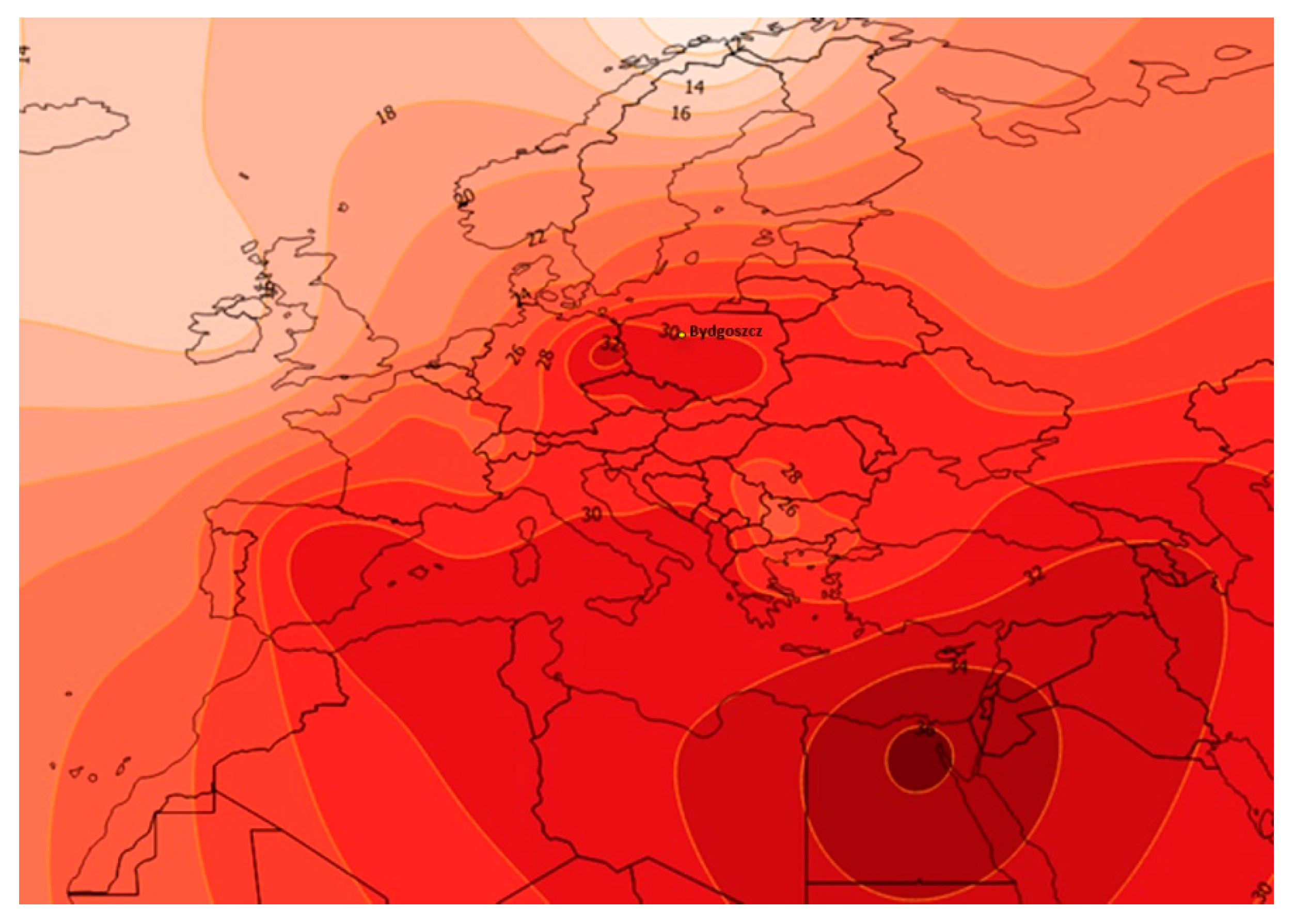


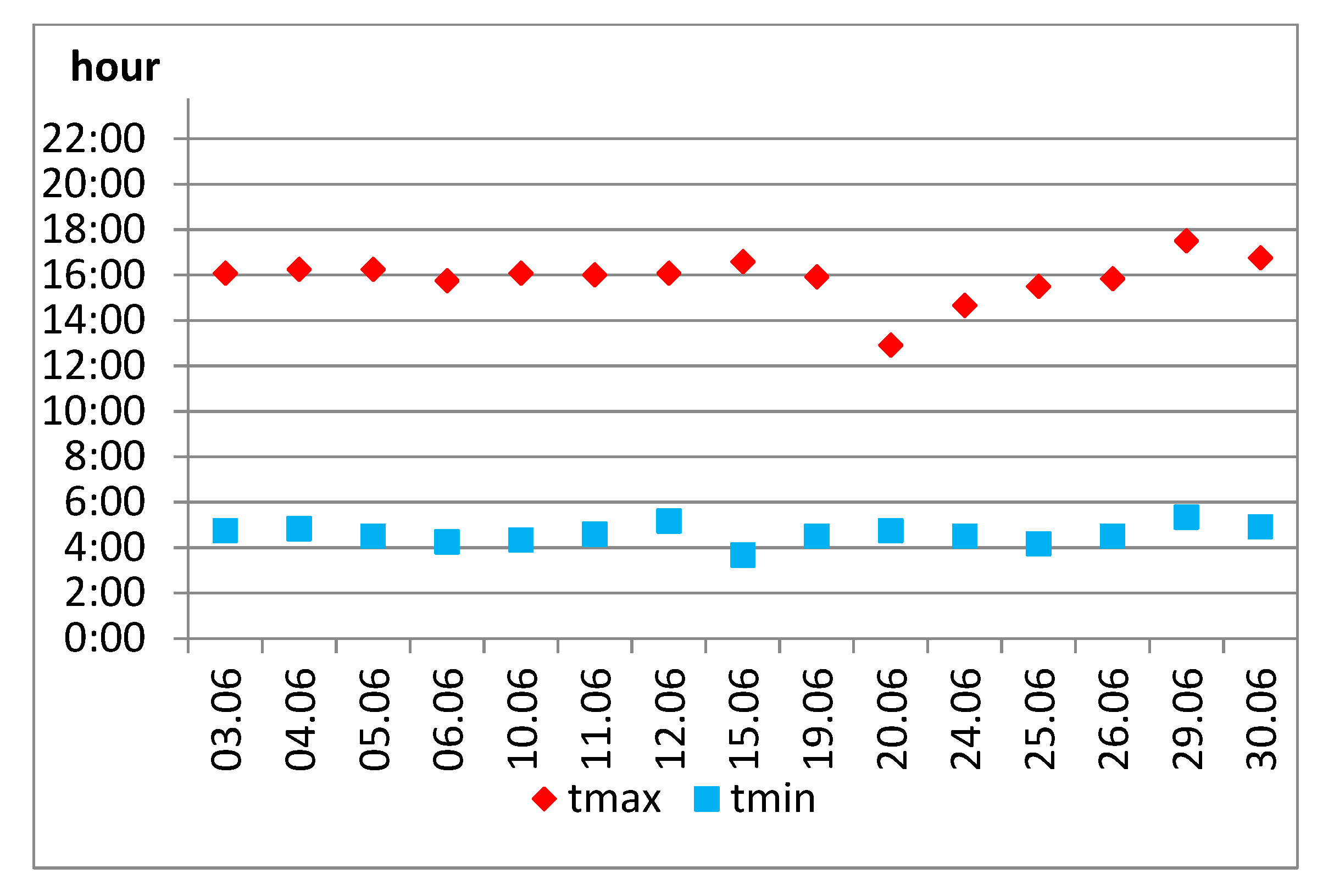
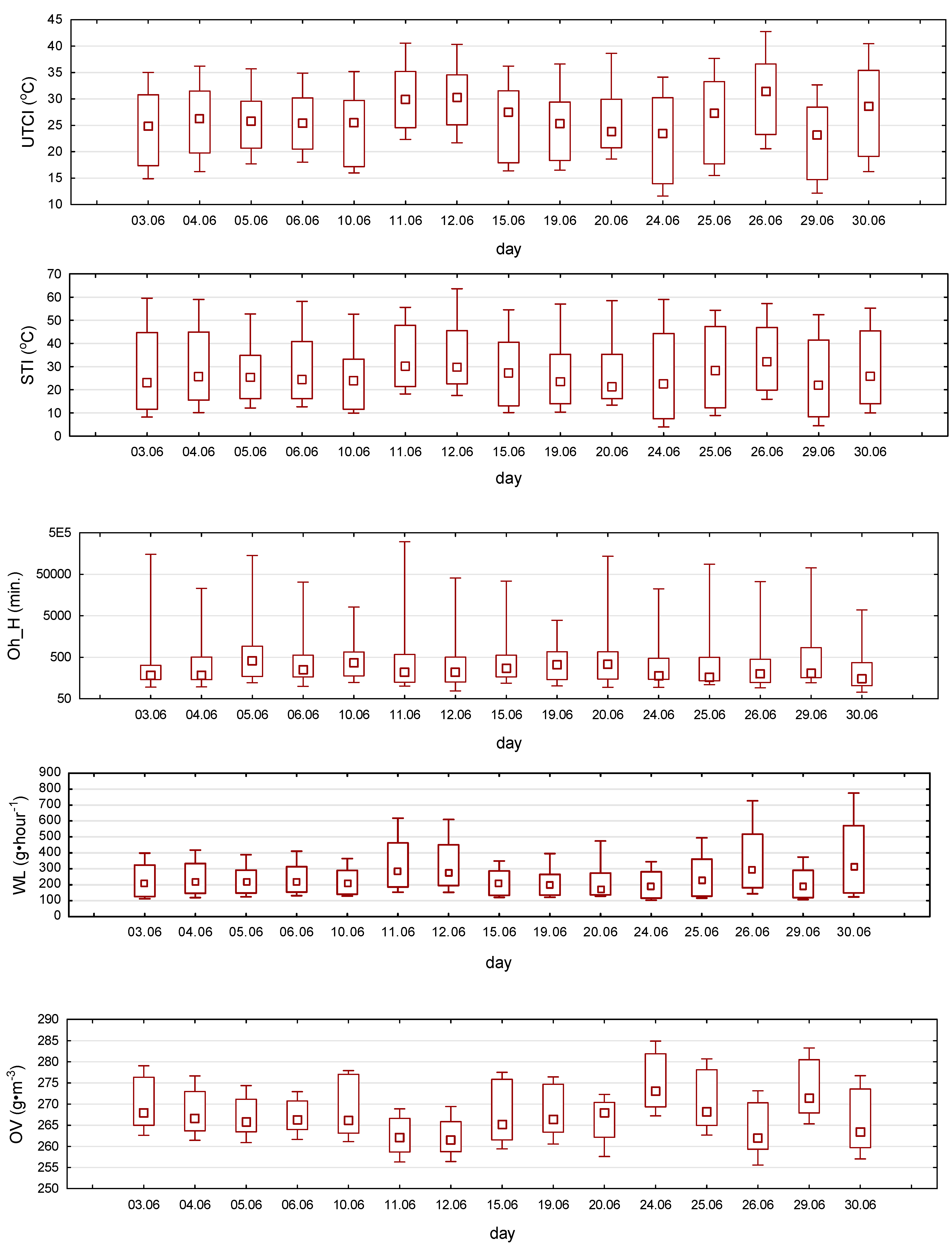
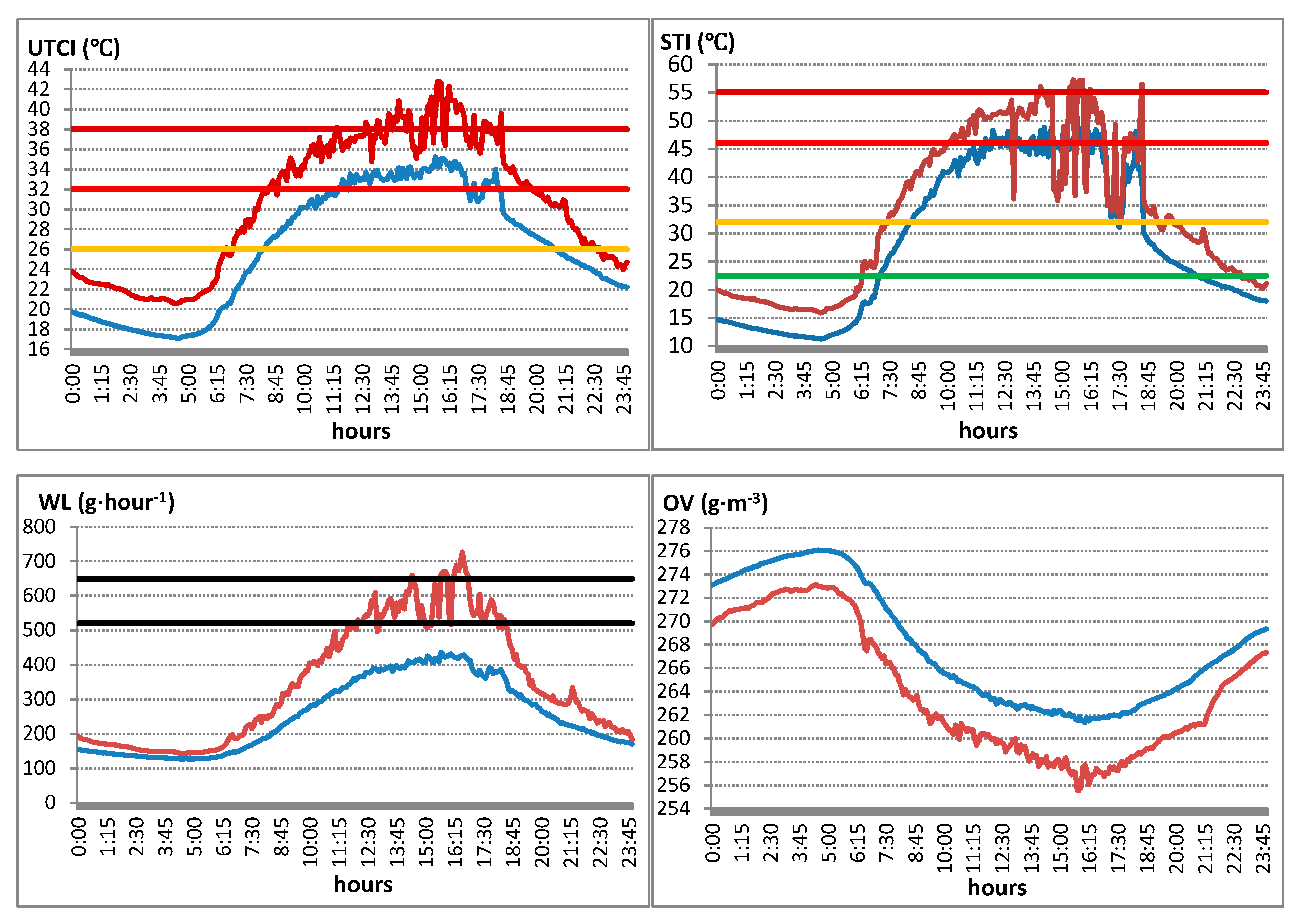
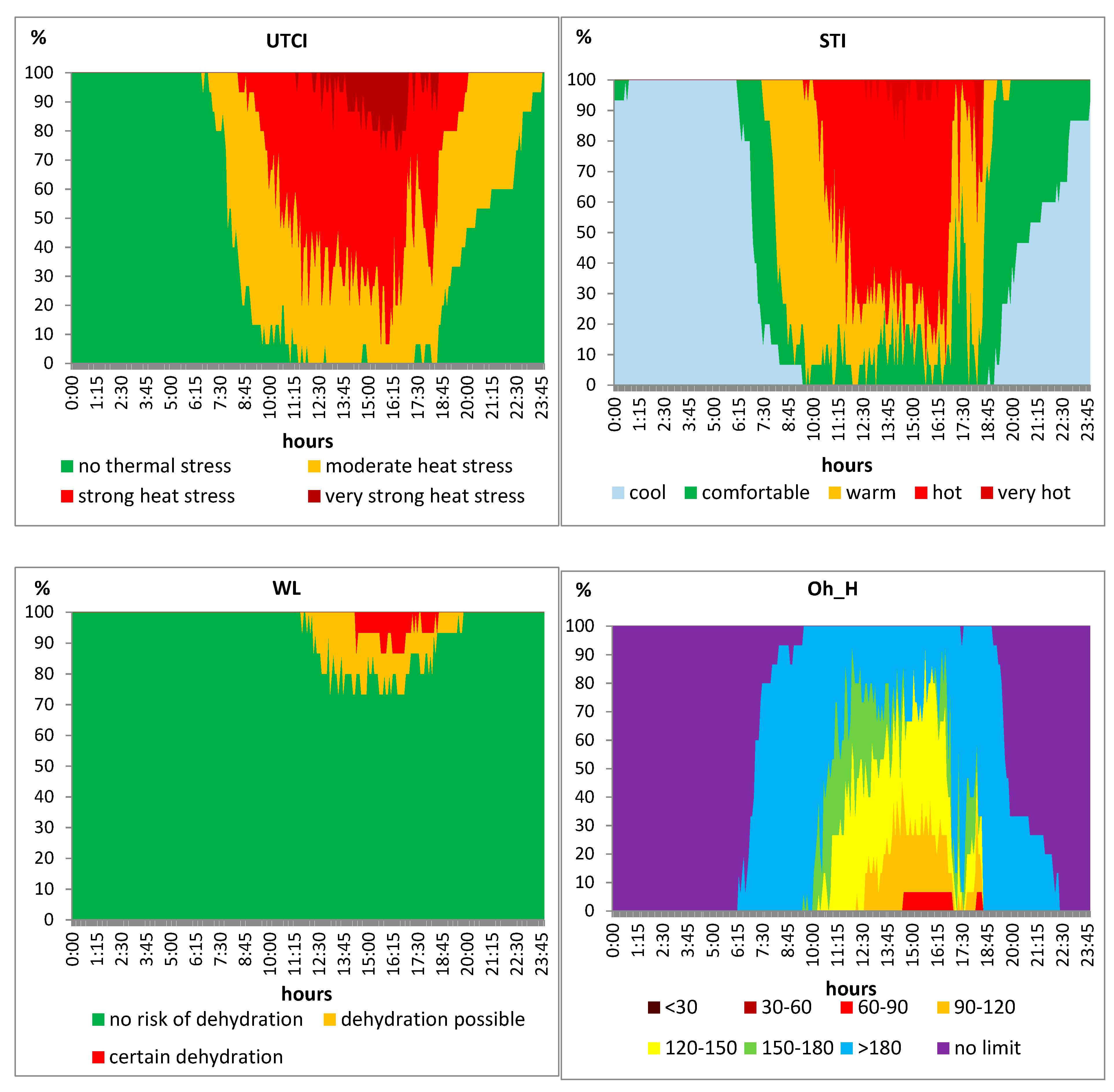
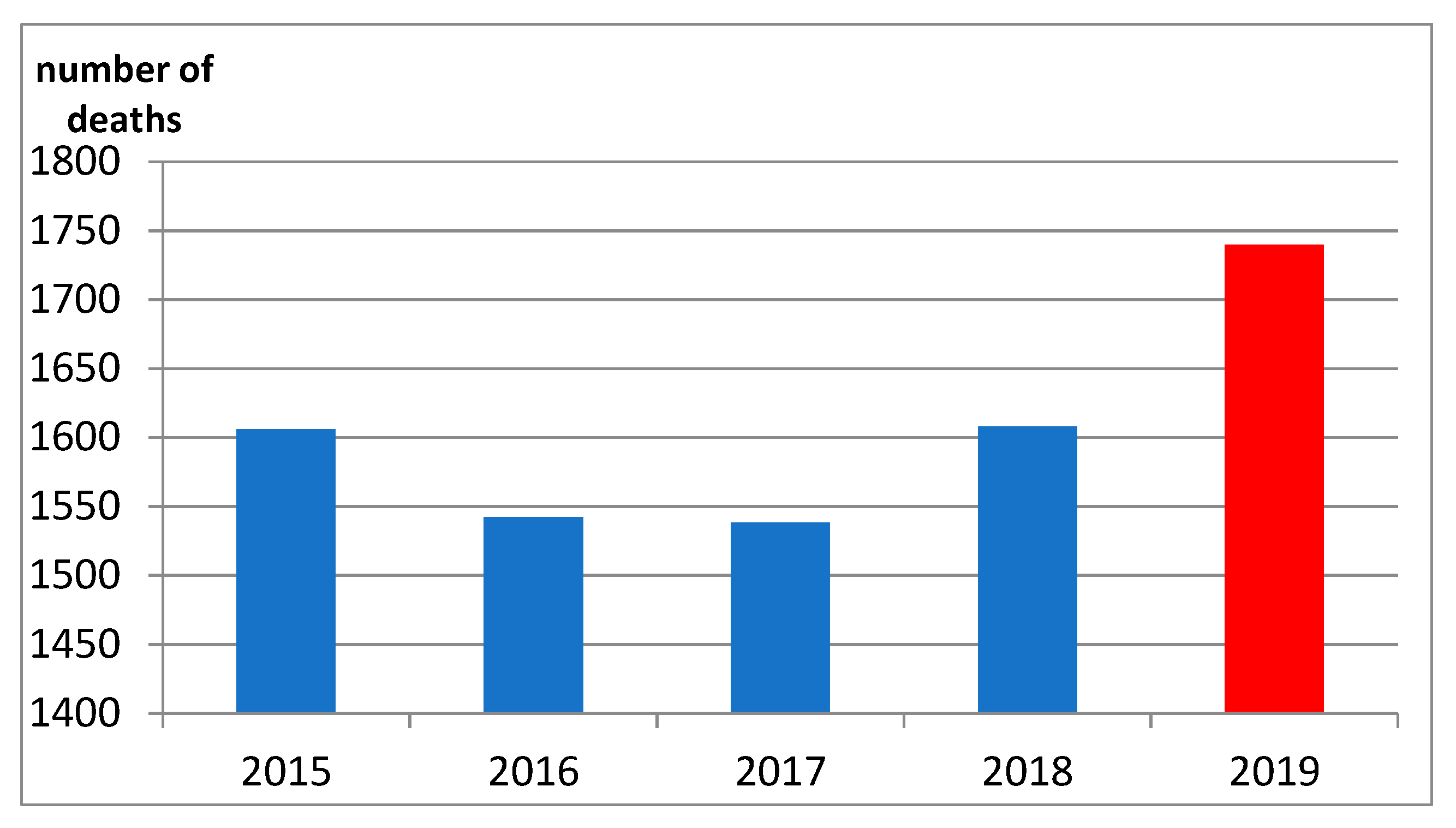
| UTCI (°C) | Stress Category and Recommendations for Protection |
|---|---|
| >46.0 | extreme heat stress, periodical cooling and drinking > 0.5 L·h–1 necessary; stay without activity |
| 38.1 to 46.0 | very strong heat stress, periodical use o fair conditioning or shaded sites and drinking > 0.5 L·h–1 necessary; reduce activity |
| 32.1 to 38.0 | strong heat stress, drinking > 0.25 L·h–1 necessary, use shade places and reduce activity |
| 26.1 to 32.0 | moderate heat stress, drinking > 0.25 L·h–1 necessary |
| 9.1 to 26.0 | no thermal stress, physiological thermoregulation sufficient to keep comfort |
| 0.1 to 9.0 | slight cold stress, use gloves and cap |
| −13.0 to 0.0 | moderate cold stress, increase activity, protect extremities and face against cooling |
| −27.0 to −12.9 | strong cold stress, strongly increase activity, protect face and extremities; use better insulated clothing |
| −40.0 to −26.9 | very strong cold stress, strongly increase activity, protect face and extremities; use better insulated clothing, reduce stay outdoor |
| <−40.0 | extreme cold stress, stay indoor or use heavy, wind protected clothing |
| STI (°C) | Subjective Thermal Sensation |
|---|---|
| <−38.0 | very cold |
| −38.0 to −0.5 | cold |
| −0.6 to 22.5 | cool |
| 22.6 to 32.0 | comfortable |
| 32.1 to 46.0 | warm |
| 46.1 to 55.0 | hot |
| 55.1 to 70.0 | very hot |
| >70.0 | sweltering |
| Change of Oxygen Volume (dOV, g∙m−3) | Stimulus Intensity |
|---|---|
| <2.6 | inert |
| 2.6–5.0 | weak |
| 5.1–10.0 | significant |
| >10 | strong |
| Day | t (°C) | f (%) | v (m∙s−1) | p (hPa) | Kglob (MJ∙m−2) | Number of Minutes t ≥ 30 °C | Beginning t ≥ 30 °C | Ending t ≥ 30 °C | ||||
|---|---|---|---|---|---|---|---|---|---|---|---|---|
| Mean | SD | Mean | SD | Mean | SD | Mean | SD | Sum | ||||
| 03.06 | 24.1 | 5.5 | 58.2 | 17.0 | 0.8 | 0.8 | 1012.7 | 1.2 | 24.7 | 270 | 12:15 | 17:55 |
| 04.06 | 25.3 | 5.0 | 53.9 | 15.4 | 0.6 | 0.7 | 1009.5 | 1.3 | 24.0 | 370 | 11:30 | 18:20 |
| 05.06 | 25.4 | 4.4 | 58.1 | 14.5 | 0.5 | 0.5 | 1008.1 | 0.8 | 18.1 | 240 | 11:35 | 18:10 |
| 06.06 | 25.3 | 3.9 | 54.5 | 13.6 | 0.7 | 0.6 | 1006.8 | 0.6 | 22.9 | 140 | 12:40 | 18:05 |
| 10.06 | 24.5 | 5.0 | 57.1 | 6.3 | 0.8 | 0.4 | 1012.5 | 3.8 | 15.8 | 230 | 13:35 | 18:20 |
| 11.06 | 29.5 | 4.7 | 53.5 | 16.6 | 1.0 | 0.7 | 1007.1 | 0.8 | 23.8 | 705 | 10:00 | 21:35 |
| 12.06 | 29.6 | 4.3 | 49.4 | 13.5 | 0.9 | 0.8 | 1005.7 | 1.2 | 23.4 | 730 | 08:55 | 21:20 |
| 15.06 | 24.7 | 5.1 | 68.3 | 7.9 | 0.6 | 0.6 | 1010.1 | 3.7 | 21.6 | 255 | 14:10 | 18:40 |
| 19.06 | 24.4 | 4.9 | 60.5 | 12.5 | 0.4 | 0.5 | 1008.4 | 2.8 | 19.1 | 230 | 14:00 | 18:20 |
| 20.06 | 24.7 | 4.6 | 67.0 | 16.2 | 0.4 | 0.6 | 1005.0 | 1.1 | 18.9 | 265 | 10:05 | 15:15 |
| 24.06 | 22.0 | 6.1 | 57.6 | 17.7 | 0.5 | 0.4 | 1021.3 | 0.5 | 25.8 | 5 | 14:40 | 14:40 |
| 25.06 | 25.8 | 6.2 | 54.1 | 18.0 | 0.4 | 0.6 | 1020.3 | 1.8 | 25.1 | 565 | 10:40 | 20:15 |
| 26.06 | 29.9 | 5.6 | 52.0 | 15.6 | 0.8 | 0.8 | 1013.8 | 2.6 | 23.2 | 780 | 08:35 | 21:30 |
| 29.06 | 22.3 | 5.9 | 50.7 | 16.5 | 0.6 | 0.6 | 1015.0 | 2.2 | 24.5 | 5 | 17:30 | 17:30 |
| 30.06 | 28.5 | 7.1 | 39.7 | 18.9 | 0.9 | 0.9 | 1008.1 | 3.1 | 25.7 | 745 | 09:30 | 22:05 |
| mean | 25.7 | 5.2 | 55.6 | 14.7 | 0.7 | 0.6 | 1011.0 | 1.8 | 22.4 | - | - | - |
| Day | UTCI (°C) | STI (°C) | Oh_H (min.) | WL (g∙hour−1) | OV (g∙m−3) | |||||
|---|---|---|---|---|---|---|---|---|---|---|
| Mean | SD | Mean | SD | Mean | SD | Mean | SD | Mean | SD | |
| 03.06 | 24.5 | 6.5 | 27.9 | 15.7 | 2022.5 | 12,886.2 | 230.8 | 97.6 | 270.0 | 5.5 |
| 04.06 | 25.6 | 6.1 | 28.9 | 14.6 | 781.8 | 2527.9 | 239.8 | 96.6 | 268.0 | 4.9 |
| 05.06 | 25.6 | 5.3 | 27.2 | 12.2 | 1964.5 | 11,877.7 | 225.6 | 77.8 | 267.1 | 4.2 |
| 06.06 | 25.5 | 5.0 | 28.5 | 13.1 | 1007.2 | 3075.1 | 233.4 | 81.5 | 267.2 | 3.6 |
| 10.06 | 24.2 | 6.3 | 25.1 | 13.0 | 714.8 | 1196.9 | 216.9 | 72.7 | 269.4 | 6.5 |
| 11.06 | 30.2 | 5.6 | 33.9 | 12.8 | 3277.3 | 23,618.6 | 323.9 | 148.6 | 262.5 | 4.1 |
| 12.06 | 29.9 | 5.4 | 33.5 | 12.8 | 1176.9 | 4292.6 | 320.2 | 134.9 | 262.4 | 3.9 |
| 15.06 | 25.9 | 6.4 | 28.7 | 14.0 | 1168.2 | 3837.7 | 212.2 | 73.1 | 267.5 | 6.6 |
| 19.06 | 24.9 | 6.0 | 26.8 | 14.0 | 539.2 | 616.3 | 212.2 | 79.4 | 268.2 | 5.5 |
| 20.06 | 25.5 | 5.7 | 27.3 | 13.1 | 1946.2 | 11,676.9 | 211.0 | 88.3 | 266.5 | 4.4 |
| 24.06 | 22.8 | 7.5 | 25.6 | 17.0 | 988.3 | 2669.8 | 200.0 | 79.6 | 274.9 | 6.1 |
| 25.06 | 26.4 | 7.2 | 29.9 | 15.5 | 1355.0 | 7539.8 | 252.7 | 115.1 | 270.5 | 6.3 |
| 26.06 | 30.5 | 6.7 | 33.6 | 13.5 | 830.3 | 2911.6 | 343.7 | 171.5 | 264.0 | 5.6 |
| 29.06 | 22.4 | 6.7 | 24.5 | 15.4 | 1757.3 | 7524.9 | 210.5 | 88.7 | 273.4 | 6.2 |
| 30.06 | 28.2 | 8.0 | 29.4 | 14.1 | 432.1 | 843.6 | 370.8 | 219.3 | 265.8 | 6.8 |
| mean | 26.1 | 6.3 | 28.7 | 14.1 | 1330.8 | 6473.0 | 253.6 | 108.3 | 267.8 | 5.3 |
Publisher’s Note: MDPI stays neutral with regard to jurisdictional claims in published maps and institutional affiliations. |
© 2021 by the author. Licensee MDPI, Basel, Switzerland. This article is an open access article distributed under the terms and conditions of the Creative Commons Attribution (CC BY) license (https://creativecommons.org/licenses/by/4.0/).
Share and Cite
Okoniewska, M. Specificity of Meteorological and Biometeorological Conditions in Central Europe in Centre of Urban Areas in June 2019 (Bydgoszcz, Poland). Atmosphere 2021, 12, 1002. https://doi.org/10.3390/atmos12081002
Okoniewska M. Specificity of Meteorological and Biometeorological Conditions in Central Europe in Centre of Urban Areas in June 2019 (Bydgoszcz, Poland). Atmosphere. 2021; 12(8):1002. https://doi.org/10.3390/atmos12081002
Chicago/Turabian StyleOkoniewska, Monika. 2021. "Specificity of Meteorological and Biometeorological Conditions in Central Europe in Centre of Urban Areas in June 2019 (Bydgoszcz, Poland)" Atmosphere 12, no. 8: 1002. https://doi.org/10.3390/atmos12081002
APA StyleOkoniewska, M. (2021). Specificity of Meteorological and Biometeorological Conditions in Central Europe in Centre of Urban Areas in June 2019 (Bydgoszcz, Poland). Atmosphere, 12(8), 1002. https://doi.org/10.3390/atmos12081002





